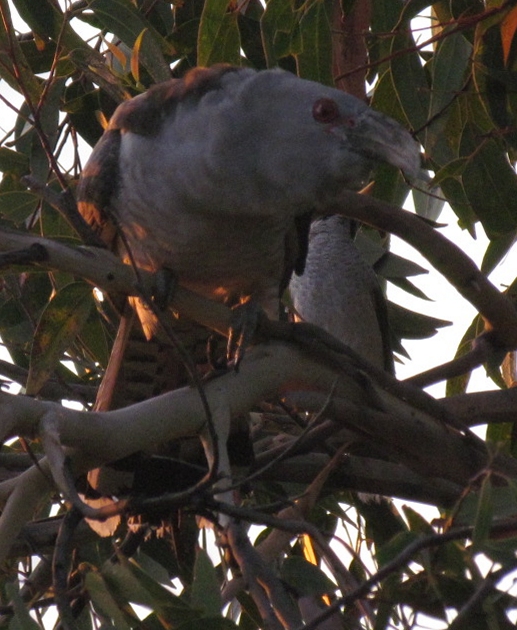Blog Archives
Koel Cuckoo regurgitates food
Today I spotted a young female Koel Cuckoo. The males are so dark in colour that it’s hard to see them in fine detail. Photographs end up being just a black blob. But this female is quite pretty.
This video shows the bird sitting quietly on the branch, not doing much. At around 20 seconds into the video, she regurgitates some fruit and then swallows it again.
Adult Koel Cuckoos have red eyes, but youngsters can keep the brown colour into their second summer. I thought I glimpsed a glint of red every now and then, but her eyes are still mostly dark brown.
Here’s another side view of her, sheltering behind the foliage:
She decided to stretch her wings. I was behind her at the time, so there’s a lovely view of soft down and the underside of her wings:
Common name: Common Koel or Eastern Koel
Scientific name: Eudynamys scolopacea
Approximate length: 45 cm
Date spotted: 27 November 2016
Season: Spring
Location: Manly Dam Reserve, New South Wales, Australia
Latitude/longitude: 33°46’35.6″S 151°15’16.8″E
Channel-billed Cuckoo fending off Australian Miners
The call of the Channel-billed Cuckoo announces that spring has arrived. These large, ugly, yet splendid birds arrive in Eastern Australia in early spring every year, returning from their seasonal migration to Indonesia and New Guinea.
They’re the largest cuckoos in the world, at a length of around 60 cm and a wingspan of 1 metre. Yet, despite their size, they’re cowed by the little Australian Miner (length 25 cm, wingspan 40 cm). To those who know Australian birds, this isn’t surprising. The Miner, also known as the Noisy Miner, is aggressive and fearless, attacking birds and animals far larger than itself.
In this video you can hear the pesky Australian Miners chirping and heckling, and the cuckoo hissing and groaning in response:
This video shows a couple of Noisy Miners dive-bombing the cuckoo:
Here’s the cuckoo in a moment of quiet contemplation. Note the red eyes and the large, curved beak:
A view of the cuckoo from behind, surrounded by gum tree flowers:
Common name: Channel-billed Cuckoo
Scientific name: Scythrops novaehollandiae
Approximate length: 58-65 cm
Date spotted: 8 October 2016
Season: Spring
Location: Manly Dam National Park, New South Wales, Australia
Latitude/longitude: 33°46’59.1″S 151°15’09.5″E
Cuckoos are back in town
They’re noisy creatures, but I love it when the cuckoos arrive in Sydney. They herald the start of spring. They also send the local birds into a tizzy. Territorial disputes abound. The kookaburras have a rival for their 5am wake-up duties. And the noisy miners have another large bird to terrorise.
The cuckoos are migratory, spending the warmer half the year in Australia and the cooler half in Indonesia, Papua New Guinea and other northern climes. Two types of cuckoos make themselves known in our neighbourhood by their loud calls: the Channel-billed Cuckoos and the Koel Cuckoos.
Channel-billed Cuckoo
The Channel-billed Cuckoos are the largest cuckoos in the world. With their red eyes and large beaks, they’re an impressive sight. Today I was lucky to see one reasonably close by, and I was amazed by the way it moves. This one was being bothered by a noisy miner. The cuckoo was constantly bending and wriggling its neck to try and spot its tormentor. At the end of the video, you’ll see it looking up in alarm then disappearing with a flash of its tail, as the much smaller miner dive-bombs it.
Here’s a still photo of the same cuckoo peering out from underneath a canopy of leaves:
In this one, the cuckoo is looking reasonable relaxed but on the alert for attack:
And here it’s definitely wary:
Common name: Channel-billed Cuckoo
Scientific name: Scythrops novaehollandiae
Approximate length: 58-65 cm
Date spotted: 1 November 2015
Season: Summer
Location: Allambie Heights, New South Wales, Australia
Latitude/longitude: 33°46’13.9″S 151°15’39.2″E
Koel Cuckoo
Then there are the Koel Cuckoos, like this one who came calling recently:
Here’s a photo of the Koel Cuckoo in full throat:
Common name: Common Koel or Eastern Koel
Scientific name: Eudynamys scolopacea
Approximate length: 45 cm
Date spotted: 11 October 2015
Season: Summer
Location: Allambie Heights, New South Wales, Australia
Latitude/longitude: 33°46’13.9″S 151°15’39.2″E









